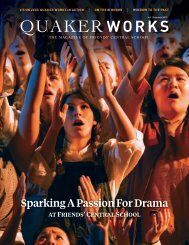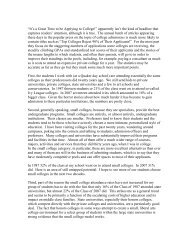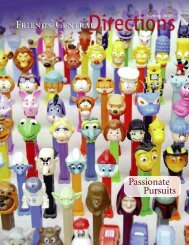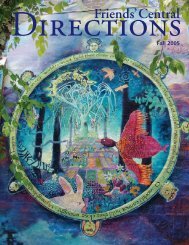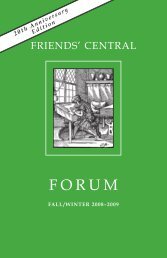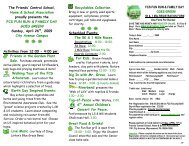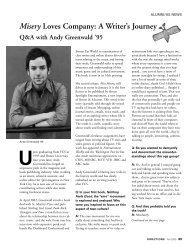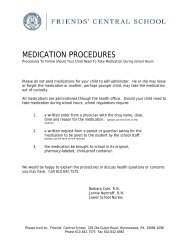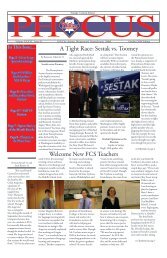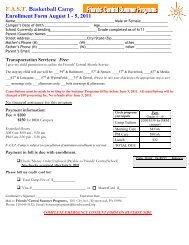10th_Summer Reading_2009 - Friends' Central School
10th_Summer Reading_2009 - Friends' Central School
10th_Summer Reading_2009 - Friends' Central School
Create successful ePaper yourself
Turn your PDF publications into a flip-book with our unique Google optimized e-Paper software.
FRIENDS’ CENTRAL SCHOOL 10 TH GRADE SUMMER READING LIST (<strong>2009</strong>-2010)<br />
Sophomores are required to read the novel Of Mice and Men by John Steinbeck and Nickel and<br />
Dimed by Barbara Ehrenreich. The books were chosen as a pair because of the many interesting<br />
ways they connect with each other while at the same time introducing several important themes<br />
that we will continue to follow through the rest of the year.<br />
There will be a quiz on these works on the first day of class, and they will form the basis of our<br />
first unit of study in the fall. Thus you will need your own copy of the texts to use in class. Take<br />
notes and mark up the texts as you read. In order to help guide your reading and to prepare you<br />
for our study of the two texts when we return to school in September, we have compiled the<br />
questions below for your consideration.<br />
In addition, all students must select and read one additional book from the attached optional list.<br />
This book will be discussed during the first week of school in a group composed of other<br />
students who read that book and the teacher who selected it.<br />
1. What makes the stories depicted in these works tragic? Having studied the tragedy of<br />
Macbeth in 9 th grade, do you see any correlations between its tragic elements and the<br />
forces operating in Ehrenreich's and Steinbeck's narratives? In what ways might an<br />
understanding of a model tragedy like Macbeth help us make sense of the conflicts in<br />
Nickel and Dimed and Of Mice and Men?<br />
2. In a 1938 journal entry, John Steinbeck wrote, "if you understand [another person], you<br />
will be kind to each other. Knowing a man well never leads to hate and nearly always<br />
leads to love." How do the relationships and friendships in both texts foster this kind of<br />
knowledge and understanding of others? What prevents such understanding?<br />
3. Both Of Mice and Men and Nickel and Dimed examine the ways in which people come<br />
to understand themselves as a part of a larger, multi-faceted world. How do the<br />
individuals in both texts navigate and understand the political, cultural and/or social<br />
structures in which they live?<br />
4. Both books are set in work worlds that depend on their employees, but simultaneously<br />
devalue them. What are some specific ways that the hired hands in Of Mice and Men<br />
and the unskilled laborers in Nickel and Dimed are kept in their places and made to feel<br />
of little worth or even expendable?<br />
5. If the message from the employers in both books is, finally, that their workers have little<br />
personal value, how do the laborers and employees manage to find meaning or selfrespect,<br />
and how effective are these forms of survival and resistance?<br />
6. In different ways Ehrenreich and Steinbeck create stories that reveal environments and<br />
people who are often invisible within society. What is the purpose and value of telling
these stories? What influence does the choice of form (documentary/participant vs.<br />
fictional re-creation) have on the impact of the stories themselves?<br />
7. There is a Quaker saying, “Let your life speak.” What do the lives Ehrenreich and<br />
Steinbeck depict in these texts “speak” to us? What do these stories in particular reveal<br />
about the nature and value of storytelling?<br />
FRIENDS’ CENTRAL SCHOOL <strong>2009</strong> OPTIONAL SUMMER READING<br />
Many teachers, not just English teachers, like to read and talk about books—and many different<br />
kinds of books, not just the kind that occur to English teachers to select, are stimulating and<br />
enjoyable. You’ll find 28 books listed below, each with the name of a recommending teacher<br />
attached. We’re confident that we’ve come up with something for everyone. Choose one of<br />
these books and read it. When we come back to school in the fall, we’ll organize book<br />
discussion groups—about a class block in length—where you can talk about the book with the<br />
teacher who recommended it and the other students in 10 th , 11 th , and 12 th grade who chose to<br />
read it. Make sure you have a few things to say about the book when your group meets—and<br />
have a great summer, both while you’re reading and while you’re not!<br />
This year’s choices (select one):<br />
Please choose a new book—do not read a book you read for this project in previous years.<br />
1. Incident at Vichy by Arthur Miller Mme.<br />
Ostroff-Weinberg<br />
From books.google.com:<br />
In Vichy France in 1942, eight men and a boy are seized by the collaborationist authorities and<br />
made to wait in a building that may be a police station. Some of them are Jews. All of them have<br />
something to hide-- if not from the Nazis, then from their fellow detainees and, inevitably, from<br />
themselves. For in this claustrophobic antechamber to the death camps, everyone is guilty. And<br />
perhaps none more so than those who can walk away alive. In Incident at Vichy, Arthur Miller<br />
re-creates Dante's hell inside the gaping pit that is our history and populates it with sinners<br />
whose crimes are all the more fearful because they are so recognizable.<br />
2. Q & A by Vikas Swarup<br />
Dr. Patterson<br />
The novel that inspired the 2008 Best Picture, “Slumdog Millionaire.” The hero, Ram<br />
Mohammad Thomas, poor and ill-educated, becomes the winner on an Indian version of "Who<br />
Wants to Be a Millionaire" and is catapulted to fame. He is also accused of cheating, since it
seems impossible that someone from his caste could possibly win on his own merits. Narrated in<br />
first person by Ram, his story reveals how the answers to the questions have come from the<br />
uncanny experiences he has had in his short life. The book is different enough from the movie<br />
that one can't substitute for the other, but similar enough that you can read the book and watch<br />
the film and decide which is better. Or just read the book.<br />
3. True Notebooks: A Writer’s Year at Juvenile Hall by Mark Salzman Ms.<br />
Morton<br />
True Notebooks chronicles the year novelist Mark Salzman (Lost in Place, Iron and Silk) taught<br />
creative writing at <strong>Central</strong> Juvenile Hall, a youth detention center in Los Angeles. The book<br />
focuses on the lives of Salzman’s students—teenagers considered “high-risk offenders,” most<br />
awaiting trial for “187s” (police code for murder). Salzman reveals glimpses of these students’<br />
lives through their own writing, which is crude, terrifying, and sometimes shockingly beautiful.<br />
I read this in high school and am still haunted by one of the poems in the book. This is powerful,<br />
moving, well-written…and absolutely true.<br />
4. The Book of Lost Things by John Connolly<br />
Ms. Torpey<br />
Twelve-year old David is mourning his mother's death and resisting the changes it brings--his<br />
father's marriage to Rose, and their move out of London to the house where Rose grew up.<br />
David's room in the house, high in the attic, is filled with books from a previous occupant. The<br />
books have started talking to David, and he is having trouble keeping the fairy-tale world of the<br />
books and the real world separate. As fantasy becomes David's reality, he hears his mother's<br />
voice calling to him, and one night he follows it . . . . Check out the website:<br />
http://www.thebookoflostthings.com/<br />
5. Wuthering Heights by Emily Bronte<br />
Ms. Goldader<br />
"Twilight" fans, you know this is Bella's favorite book. How similar is the love story of Bella<br />
and Edward to that of Catherine and Heathcliff? Read, and let's talk about it.<br />
6. The Breakthrough: Politics and Race in the Age of Obama by Gwen Ifill<br />
Mr. Crauderueff<br />
In The Breakthrough, Gwen Ifill offers her analysis of contemporary African American politics,<br />
which have developed a new identity in recent years. The book is based on Ifill’s long-term<br />
observations as a newspaper reporter and correspondent, as well as interviews she completed<br />
with significant African American politicians. She particularly investigates the “sandpaper<br />
moments” that cause initial discomfort but ultimately lead to transformation in the areas of age,<br />
gender, region and – of course – race.<br />
7. In Small Things Forgotten by James Deetz<br />
Dr. Graham<br />
Or, clay pots, tombstones, and brick houses - oh, my! This short paperback book on the<br />
archaeology of early America is not your usual FCS book, because it's not fiction and no one<br />
dies. Deetz takes a look at the way that historical artifacts speak to us, in what historians call a
"material cultures" approach to the past. For example, in the chapter "Remember me as you pass<br />
by," he looks at the way that changes in the carving of tombstones show changing attitudes<br />
towards death. He considers houses, dishes, and the archaeological research into a small<br />
community called "Parting Ways," a free black community established in Massachusetts at the<br />
end of the 18th century. Something fun to read if you feel like getting your history on!<br />
8. The Thirteenth Tale by Diane Setterfield<br />
Ms. Novo<br />
The Thirteenth Tale opens with a letter from one book-loving stranger to another: Vida Winter,<br />
the most famous and flamboyant writer in England, writes to Margaret Lea, who runs a rare book<br />
shop with her father and has never read a single one of Vida’s books. Over many years, Vida<br />
has spun implausible, fantastic tales about her origins to countless interviewers—and now, out of<br />
the blue, invites Margaret to become her official biographer, promising finally to reveal<br />
truthfully the secrets of her past. To her own surprise, Margaret takes her up on the offer,<br />
traveling to Vida’s mysterious, decrepit family home to interview her. Margaret is surprised to<br />
find how strongly she is attracted to Vida; at the same time she is suspicious, a scholar who vows<br />
to test the validity of each part of Vida’s story. The story that unfolds is hard to believe and yet<br />
compels belief, and the relationship between Vida and Margaret, storyteller and recipient, is<br />
replicated in the relationship that develops between Margaret, the novel’s narrator, and us, its<br />
readers as we travel through this world of ghosts, mistaken identity, secrets, surprises, disaster,<br />
disguise, loneliness, suspense and, ultimately, resolution.<br />
9. The Elegance of the Hedgehog by Muriel Barbery<br />
Ms. Schumacher<br />
Renee is a concierge for an elegant residence in Paris. Subjected to the ignorance of the elite<br />
tenants of the building, she plays into the stereotypes they believe apply to all those who are not<br />
rich like themselves. In reality, Renee is a genius, a lover of Tolstoy and Japanese films.<br />
Paloma is a twelve-year-old tenant of the same building for which Renee is a concierge. Paloma<br />
is disillusioned by all the wealth she sees around her. She too is bright, but she has also decided<br />
that upon her thirteenth birthday, she will kill herself. However, both Paloma and Renee’s lives<br />
will be turned upside down when a new resident moves into their elite Parisian apartment<br />
building. Join me for a delightful adventure into the Parisian world of Paloma and Renee.<br />
10. The Blind Side: Evolution of a Game by Michael Lewis<br />
Mr. Morris<br />
From npr.org:<br />
If you read the big stories about NFL football, you'll notice that some positions get a lot more<br />
attention than others: receivers, quarterbacks and running backs. Sometimes even menacing<br />
linebackers or brilliantly athletic cornerbacks get attention, too. But Michael Lewis' new book<br />
about football, The Blind Side, makes a counterintuitive argument: that the pivotal position on a<br />
football team today is the offensive left tackle. Through the story of Michael Oher, a top-notch<br />
football prospect with the rare qualities of a "perfect" offensive left tackle, The Blind Side traces<br />
how the position's importance has evolved, and how money has affected the game.
11. A Thousand Splendid Suns by Khaled Hosseini<br />
Ms. Gowen-Tolcott<br />
When I read this novel last year, I was profoundly moved. This is a tale of the struggle of<br />
women in the Afghan society during the past thirty years. In this novel, love, friendship and<br />
sacrifice play major roles. In a clear and powerful style, the author shows how the political<br />
events that annihilated a country could not destroy the resilience of the main characters. Since<br />
Afghanistan is still facing an uncertain fate, this novel is timely and compelling, and makes us<br />
hope for a better future for its citizens, especially the women.<br />
12. Measure for Measure AND Troilus and Cressida by William Shakespeare<br />
Terry Guerin<br />
Let’s talk politics, sexual and otherwise, in two of Shakespeare's more obscure "problem" plays.<br />
13. The Book Thief by Markus Zusak<br />
Mrs. Brodsky<br />
Last spring, while browsing in a bookstore in Sydney, Australia, I decided I should read a book<br />
by an Australian author. The Book Thief was my choice and once I got through the first 30<br />
pages, I couldn't put it down! The story, set in Nazi Germay, begins as a young Liesel Meminger<br />
travels to a small town outside of Munich. Along the way, her brother dies and during his<br />
funeral, Liesel steals her first book, The Gravedigger’s Handbook. Narrated by Death, The Book<br />
Thief tells the story of Liesl over the next five years: her foster parents, the ill-tempered Rosa and<br />
mellow, accordion-playing Hans (who teaches her to read her first stolen book), her best friend<br />
Rudy, the poverty-stricken life she leads in wartime Germany, the books she steals, the Jew in<br />
the basement and the words that inspire them all.<br />
14. Memories of Amnesia by Lawrence Shainberg<br />
Mr. Sheppard<br />
For those who prefer their humor dark, keep reading. If you're also kept up at night by the<br />
haunting fact that your precious consciousness is somehow born from that ugly, wrinkled mass<br />
of neurons and blood vessels resting easy on your pillow, this book is for you. When an<br />
insightful brain surgeon begins to observe, in himself, symptoms of brain disease, his medical<br />
knowledge becomes a blessing and a curse. Horrified and curious, he forges ahead on a<br />
precarious path as both patient and doctor, protagonist and antagonist, host and disease. Through<br />
infected and infecting prose, come see what happens as a man's mind erodes before your eyes,<br />
and self- discovery becomes inextricable from self-destruction.<br />
15. Remainder by Tom McCarthy<br />
Mr. Kennedy<br />
Jonathan Lethem, one of our best novelists, describes Remainder as "a stunningly strange book<br />
about the rarest of fictional subjects: happiness." He is not wrong. A man recovering from a<br />
random and rather serious injury receives an enormous financial settlement for his pain. What to<br />
do with the money? Charity? Self-indulgence? No, he wants to feel real again. The only way<br />
he can think to make that happen is to recreate a moment from his past and place himself in that<br />
space. What starts out as a harmless quest becomes a deadly obsession in this Kafkaesque tale.<br />
By the time you realize you are trapped in McCarthy's world you will not be able to find the exit,<br />
much less use it.
16. The Hours by Michael Cunningham<br />
Ms. Ewen<br />
“Mrs. Dalloway said she would buy the flowers herself.” This famous opening line of Virginia<br />
Woolf’s Mrs. Dalloway is the thread that intertwines the lives of three women in Cunningham’s<br />
Pulitzer-Prize winning novel—Virginia Woolf herself, Laura Brown, a housewife who turns the<br />
pages of Woolf’s novel, and Clarissa Vaughn, a modern Manhattanite whom we meet as she sets<br />
out to buy flowers for a party she’s giving. The novel traces a day in the life of these three<br />
women who are separated by history but who are drawn to the fictional character of Mrs.<br />
Dalloway and the parts of their own lives they see in hers.<br />
17. Mona in the Promised Land by Gish Jen<br />
Mr. MacFarlane<br />
An admired former professor of mine at college includes Gish Jen in her list of the top ten<br />
underappreciated American Women writers, "one of the funniest and most free-wheeling<br />
novelists of the multicultural<br />
90s." This first got me interested in reading her. When I saw the Amazon.com description of the<br />
title character of this novel, I thought many students here might appreciate an introduction to the<br />
author as<br />
well. Mona, it tells us, is "a self-described 'self-made mouth' [who] goes to temple, loves pickles,<br />
is boy-crazy, worries about getting into the right college and keeping up with her over-achieving<br />
sister,<br />
and wishes her parents were less strict. Her equally Jewish Westchester classmates hardly notice<br />
what everyone else finds hard to forget: Mona may be Jewish by choice (and voice) and<br />
American by nationality, but her surname is Chang and she is considered less an expert on seders<br />
and schmaltz than China."<br />
18. We Are All Welcome Here by Elizabeth Berg<br />
Ms. Haimm<br />
From borders.com:<br />
It is the summer of 1964. In Tupelo, Mississippi, the town of Elvis's birth, tensions are mounting<br />
over civil-rights demonstrations occurring ever more frequently -- and violently – across the<br />
state. But in Paige Dunn's small, ramshackle house, there are more immediate concerns.<br />
Challenged by the effects of the polio she contracted during her last month of pregnancy, Paige<br />
is nonetheless determined to live as normal a life as possible and to raise her daughter, Diana, in<br />
the way she sees fit – with the support of her tough-talking black caregiver, Peacie. As the<br />
summer unfolds, hate and adversity will visit this modest home. Despite the difficulties thrust<br />
upon them, each of the women will find her own path to independence, understanding, and<br />
peace. And Diana's mother, so mightily compromised, will end up giving her daughter an<br />
extraordinary gift few parents could match.
17. Idea Factory: Learning to Think at MIT by Pepper White Mr.<br />
Buckingham<br />
“Getting an education at MIT is like getting a drink of water from a firehose,'' says one of<br />
White's fellow students in this grad school memoir. Test anxiety, lab-project drama, and stylish<br />
prose propel White's recollections with enough force to make three years of engineering study<br />
compelling, even to readers committed to the liberal arts. The professors' egos, the career stakes,<br />
and the quizzes are presented as intense. This is a personal story of the educational process at one<br />
of the world's great technological universities. Pepper White entered MIT in 1981 and received<br />
his master's degree in mechanical engineering in 1984. His account of his experiences, written in<br />
diary form, offers insight into graduate school life in general--including the loneliness and even<br />
desperation that can result from the intense pressure to succeed--and the purposes of engineering<br />
education in particular. The first professor White met at MIT told him that it did not really matter<br />
what he learned there, but that MIT would teach him how to think.<br />
18. The No. 1 Ladies’ Detective Agency by Alexander McCall Smith<br />
Ms. Plunkett<br />
From the book jacket:<br />
The first novel in Alexander McCall Smith’s widely acclaimed The No. 1 Ladies’ Detective<br />
Agency series tells the story of the delightfully cunning and enormously engaging Precious<br />
Ramotswe, who is drawn to her profession to “help people with the problems in their lives.”<br />
Immediately upon setting up shop in a small storefront in Gaborone, she is hired to track down a<br />
missing husband, uncover a con man, and follow a wayward daughter. But the case that tugs at<br />
her heart, and lands her in danger, is that of a missing eleven-year-old boy, who may have been<br />
snatched by witch doctors.<br />
19. Why Is Sex Fun: The Evolution of Human Sexuality by Jared Diamond<br />
Mr. Vernacchio<br />
If you enjoyed Jared Diamond’s visit to FCS this Spring and his intellectual yet approachable<br />
way of talking about complex subjects – or if you’re just interested in human sexuality – this is a<br />
great book for you. Diamond calls humans the “animals with the weirdest sex lives” and in this<br />
book he explores the evolutionary path that led to such behaviors as sex for pleasure, sex as a<br />
private behavior, the role of the human male in sex, and the reason for female menopause; the<br />
topics are hetero-centric, but fascinating nonetheless. Written in a scholarly and scientific tone,<br />
this book is certainly not a “how-to” manual, but rather an interesting exploration of why humans<br />
behave the way they do. As Diamond says in his preface, “…the book may help you understand<br />
why your body feels the way it does, and why your beloved is behaving the way he or she is.”<br />
20. 1984 by George Orwell<br />
Mr. Dankoff<br />
In a world where Big Brother is always watching you and Thought Police can practically read<br />
your mind, Winston Smith is in grave danger for the simple reason that his memory still<br />
functions. Written in 1949 amidst the anti-communist hysteria of the Cold War, the novel<br />
depicts a future totalitarian government that censors everyone’s behavior and thoughts. Winston<br />
is disgusted with his oppressed life and secretly longs to join the fabled Brotherhood, a supposed
group of underground rebels intent on overthrowing the government. When I read this book in<br />
high school, my understanding of the world’s potential cracked wide open.<br />
21. Nine Stories by J.D. Salinger<br />
Ms. Lager<br />
Everyone in the world has read The Catcher in the Rye, that edgy book about growing up in New<br />
York and being the sharp-eyed Holden Caulfield. At about the same time, its author, J.D.<br />
Salinger, was writing short stories, published in one slim volume called Nine Stories. This book<br />
includes children who are too wise for their years, teenagers who steal, and unhappy and<br />
disappointed adults wishing they were children again. Altogether, the stories may be the most<br />
read short stories in contemporary fiction with the most remembered characters, like the<br />
Laughing Man, Esme, Teddy and Uncle Wiggly.<br />
22. Little Heathens by Mildred Armstrong Kalish<br />
Ms. McConnell<br />
Having spent childhood days of simple bliss on my grandparents' farm in Honeybrook, Chester<br />
County, I was immediately drawn to the possibility of reliving, or at least rethinking, some of<br />
those memories. After a chockfull school year, I find myself ready for a simple and good read<br />
like that afforded by Little Heathens. The author, Mildred Kalish, writes about growing up on her<br />
grandparents' Iowa farm during the Great Depression. Instead of focusing on the hardships<br />
presented, she tells of "the legacy of kinship, kindness and remembered pleasures." I'm looking<br />
forward to reading in the moment. Make me a promise. If you choose this book for your summer<br />
reading, you will take out your earbuds and turn off your cell phone.<br />
23. The Lone Ranger and Tonto Fistfight in Heaven by Sherman Alexie Jim<br />
Rosengarten<br />
The back of this book reads, “In this darkly comic short story collection, Sherman Alexie, a<br />
Spokane/Coeur d'Alene Indian, brilliantly weaves memory, fantasy, and stark realism to paint a<br />
complex, grimly ironic portrait of life in and around the Spokane Indian Reservation. These<br />
twenty-two interlinked tales are narrated by characters raised on humiliation and governmentissue<br />
cheese, and yet are filled with passion and affection, myth and dream.” I remember being<br />
enthralled by Alexie, not only as a story-teller, of which he is a fine one, but also with his ability<br />
to portray humanity in all its complicated beauty. I hope you join me for a great read which is<br />
bound to lead to a great chat.<br />
24. Black Ice by Lorene Cary<br />
Ms. Johnson<br />
From randomhouse.com:<br />
In 1972 Lorene Cary, a bright, ambitious black teenager from Philadelphia, was transplanted into<br />
the formerly all-white, all-male environs of the elite St. Paul's <strong>School</strong> in New Hampshire, where<br />
she became a scholarship student in a "boot camp" for future American leaders. Like any good<br />
student, she was determined to succeed. But Cary was also determined to succeed without
selling out. This wonderfully frank and perceptive memoir describes the perils and ambiguities<br />
of that double role, in which failing calculus and winning a student election could both be<br />
interpreted as betrayals of one's skin.<br />
25. The Liars’ Club by Mary Karr<br />
Mrs. Sabaj-Perez<br />
From amazon.com:<br />
In this funny, razor-edged memoir, Mary Karr, a prize-winning poet and critic, looks back at her<br />
upbringing in a swampy East Texas refinery town with a volatile, defiantly loving family. She<br />
recalls her painter mother, seven times married, whose outlaw spirit could tip into psychosis; a<br />
fist-swinging father who spun tales with his cronies--dubbed the Liars' Club; and a neighborhood<br />
rape when she was eight. An inheritance was squandered, endless bottles emptied, and guns<br />
leveled at the deserving and undeserving. With a raw authenticity stripped of self-pity and a<br />
poet's eye for the lyrical detail, Karr shows us a "terrific family of liars and drunks ... redeemed<br />
by a slow unearthing of truth."<br />
26. The Hidden Persuaders by Vance Packard<br />
Matt Murphy<br />
The Hidden Persuaders was the first book about most of the things we take for granted about<br />
marketing. The title refers to the psychological methods advertisers use to get us to buy their<br />
products, and the book is a fascinating study about the human brain. Take yourself back to 1957,<br />
before the world at large truly knew what was being pitched to us, and this book is pioneering.<br />
Even today, it stands tall as a classic examination of how our thoughts and feelings are<br />
manipulated by business, media and politicians. Much has changed in the world, but these same<br />
tenets still hold true. Read this book and learn how to beat the people who are constantly trying<br />
to brainwash you.



